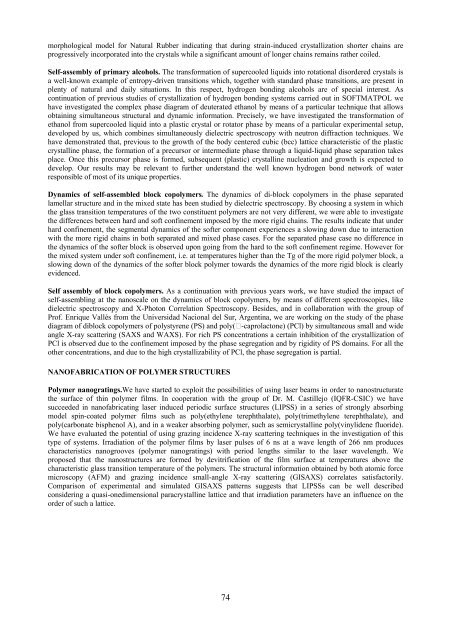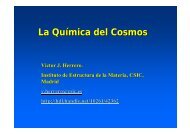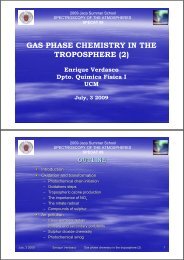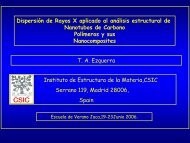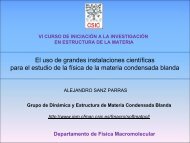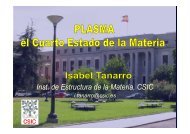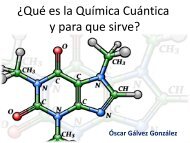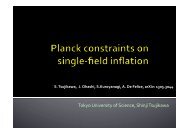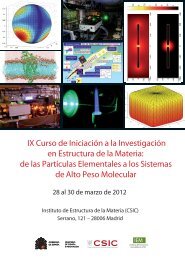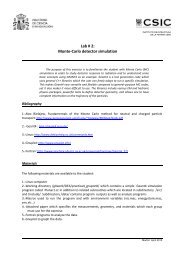morphological mo<strong>de</strong>l for Natural Rubber indicating that during strain-induced crystallization shorter chains areprogressively incorporated into the crystals while a significant amount of longer chains remains rather coiled.Self-assembly of primary alcohols. The transformation of supercooled liquids into rotational disor<strong>de</strong>red crystals isa well-known example of entropy-driven transitions which, together with standard phase transitions, are present inplenty of natural and daily situations. In this respect, hydrogen bonding alcohols are of special interest. Ascontinuation of previous studies of crystallization of hydrogen bonding systems carried out in SOFTMATPOL wehave investigated the complex phase diagram of <strong>de</strong>uterated ethanol by means of a particu<strong>la</strong>r technique that allowsobtaining simultaneous structural and dynamic information. Precisely, we have investigated the transformation ofethanol from supercooled liquid into a p<strong>la</strong>stic crystal or rotator phase by means of a particu<strong>la</strong>r experimental setup,<strong>de</strong>veloped by us, which combines simultaneously dielectric spectroscopy with neutron diffraction techniques. Wehave <strong>de</strong>monstrated that, previous to the growth of the body centered cubic (bcc) <strong>la</strong>ttice characteristic of the p<strong>la</strong>sticcrystalline phase, the formation of a precursor or intermediate phase through a liquid-liquid phase separation takesp<strong>la</strong>ce. Once this precursor phase is formed, subsequent (p<strong>la</strong>stic) crystalline nucleation and growth is expected to<strong>de</strong>velop. Our results may be relevant to further un<strong>de</strong>rstand the well known hydrogen bond network of waterresponsible of most of its unique properties.Dynamics of self-assembled block copolymers. The dynamics of di-block copolymers in the phase separated<strong>la</strong>mel<strong>la</strong>r structure and in the mixed state has been studied by dielectric spectroscopy. By choosing a system in whichthe g<strong>la</strong>ss transition temperatures of the two constituent polymers are not very different, we were able to investigatethe differences between hard and soft confinement imposed by the more rigid chains. The results indicate that un<strong>de</strong>rhard confinement, the segmental dynamics of the softer component experiences a slowing down due to interactionwith the more rigid chains in both separated and mixed phase cases. For the separated phase case no difference inthe dynamics of the softer block is observed upon going from the hard to the soft confinement regime. However forthe mixed system un<strong>de</strong>r soft confinement, i.e. at temperatures higher than the Tg of the more rigid polymer block, aslowing down of the dynamics of the softer block polymer towards the dynamics of the more rigid block is clearlyevi<strong>de</strong>nced.Self assembly of block copolymers. As a continuation with previous years work, we have studied the impact ofself-assembling at the nanoscale on the dynamics of block copolymers, by means of different spectroscopies, likedielectric spectroscopy and X-Photon Corre<strong>la</strong>tion Spectroscopy. Besi<strong>de</strong>s, and in col<strong>la</strong>boration with the group ofProf. Enrique Vallés from the Universidad Nacional <strong>de</strong>l Sur, Argentina, we are working on the study of the phasediagram of diblock copolymers of polystyrene (PS) and poly(-capro<strong>la</strong>ctone) (PCl) by simultaneous small and wi<strong>de</strong>angle X-ray scattering (SAXS and WAXS). For rich PS concentrations a certain inhibition of the crystallization ofPCl is observed due to the confinement imposed by the phase segregation and by rigidity of PS domains. For all theother concentrations, and due to the high crystallizability of PCl, the phase segregation is partial.NANOFABRICATION OF POLYMER STRUCTURESPolymer nanogratings.We have started to exploit the possibilities of using <strong>la</strong>ser beams in or<strong>de</strong>r to nanostructuratethe surface of thin polymer films. In cooperation with the group of Dr. M. Castillejo (IQFR-CSIC) we havesuccee<strong>de</strong>d in nanofabricating <strong>la</strong>ser induced periodic surface structures (LIPSS) in a series of strongly absorbingmo<strong>de</strong>l spin-coated polymer films such as poly(ethylene terephtha<strong>la</strong>te), poly(trimethylene terephtha<strong>la</strong>te), andpoly(carbonate bisphenol A), and in a weaker absorbing polymer, such as semicrystalline poly(vinyli<strong>de</strong>ne fluori<strong>de</strong>).We have evaluated the potential of using grazing inci<strong>de</strong>nce X-ray scattering techniques in the investigation of thistype of systems. Irradiation of the polymer films by <strong>la</strong>ser pulses of 6 ns at a wave length of 266 nm producescharacteristics nanogrooves (polymer nanogratings) with period lengths simi<strong>la</strong>r to the <strong>la</strong>ser wavelength. Weproposed that the nanostructures are formed by <strong>de</strong>vitrification of the film surface at temperatures above thecharacteristic g<strong>la</strong>ss transition temperature of the polymers. The structural information obtained by both atomic forcemicroscopy (AFM) and grazing inci<strong>de</strong>nce small-angle X-ray scattering (GISAXS) corre<strong>la</strong>tes satisfactorily.Comparison of experimental and simu<strong>la</strong>ted GISAXS patterns suggests that LIPSSs can be well <strong>de</strong>scribedconsi<strong>de</strong>ring a quasi-onedimensional paracrystalline <strong>la</strong>ttice and that irradiation parameters have an influence on theor<strong>de</strong>r of such a <strong>la</strong>ttice.74
GISAXSAFMX-Ray beamLIPSS polymer filmExperimental set-up to perform GrazingIinci<strong>de</strong>nceSmall-Angle X-ray scattering (GISAXS) with synchrotronradiation. The X-ray beam reaches the polymer surface, nanostructured by means of LIPSS, at an angle of totalreflection. The evanescent wave propagating along the sample gives rise to diffraction features which are collectedon a screen. From the analysis of the structure in real space (AFM) and in reciprocal space (GISAXS) a verycomplete picture of the nanostructure can be obtained.Nanoimprint Lithography.We have performed studies on nanoimprint lithography (NIL) in polymers, incol<strong>la</strong>boration with the group of Professor Francesc Pérez-Murano for Centro Nacional <strong>de</strong> Microelectrónica (CNM-CSIC, Barcelona). On one hand, the process for stamp preparation was optimized. On the other hand, a study of theun<strong>de</strong>rlying physics of the nanoimprint process in polymeric materials is being carried out. The obtained structuresare being analyzed by atomic force microscopy and X-ray spectroscopyFunctional Polymer <strong>Materia</strong>ls through addition of nanoparticles. Preparation of Composite <strong>Materia</strong>ls basedon Carbon Nanofibers, Carbon Nanotubes and Graphene.Continuing our cooperation with the company GrupoAntolín Ingeniería, S.A. we have <strong>de</strong>veloped nanocomposites based on polyami<strong>de</strong> 6,6 (PA66) and carbon nanofibers(CNFs) following a new procedure. It consists essentially of the physical mixing, by a vortex mixer, of the polymermatrix, in the form of pow<strong>de</strong>r as prepared by cryogenic grinding, and the corresponding amount of CNFs. Thematerials present good electrical conductivity at lower perco<strong>la</strong>tion thresholds than those corresponding to systemsprepared by melt compounding, which is the method commonly used in the industry. Part of this study has beenpatented. In addition, we have prepared composites based on polyvinyli<strong>de</strong>ne fluori<strong>de</strong> (PVDF) and differentcarbonaceous compounds such as single wall carbon nanotubes (SWCNT), carbon nanofibers provi<strong>de</strong>d by GrupoAntolín Ingeniería, S.A., expan<strong>de</strong>d graphite (EG) and graphite. In this case, dissolution has been the synthesisprocedure. First, we are studying electrical, thermal and mechanical properties of these compounds and, secondly wewill characterize these materials from a structural and morphological point of view, in or<strong>de</strong>r to establish thecorresponding re<strong>la</strong>tionship between structure and properties. Thus, different compounds have been prepared, in awi<strong>de</strong> range of concentrations, and electrical and thermal studies have been conducted. Interesting differences havebeen observed mainly as far as electrical properties are concerned.Within the same context, nanocomposites of Poly (trimethylene terephtha<strong>la</strong>te)(PTT) containing functionalizedmulti-walled carbon nanotubes (MWCNT) have been synthesized by in situ polymerization method. In comparisonwith neat PTT, the MWCNTs reinforced nanocomposites possess higher tensile strength and Young's modulus atlow MWCNTs loading. In addition, all nanocomposites show reduction of brittleness as compared to the neat PTT.The electrical perco<strong>la</strong>tion threshold was found between 0.3 and 0.4 wt% loading of MWCNTs.During <strong>2011</strong> and in col<strong>la</strong>boration with the groups of Prof. Z. Ros<strong>la</strong>niec of the West Pomeranian University ofTechnology (Szczecin, Po<strong>la</strong>nd) and with the group of Dr. M.A. López-Manchado (ICTP-CSIC, Madrid), we havestarted preparation of Polymer/graphene (expan<strong>de</strong>d graphite) nanocomposities exploring different polymer matrixes.Initial studies indicate achievements of electrical conductivity at very low nanoadditive concentrations. Exploitationof these nanocomposites in or<strong>de</strong>r to obtain conducting and transparent materials is going on.Nanocomposites based on thermop<strong>la</strong>stic polymers reversibly crosslinked with c<strong>la</strong>y.Following the research lineinitiated some years ago, we have prepared nanocomposites of c<strong>la</strong>y with some thermop<strong>la</strong>stic polymers reversiblycrosslinked by reactive extrusion: isotactic polypropylene iPP, polyethylene, PE and isotactic polybutene-1, iPB-1 inone step. Some modifications introduced in the preparation method allowed us to improve the properties of the final75
- Page 3:
INTRODUCCIÓNEl Instituto de Estruc
- Page 10 and 11:
Dra. Maria Esperanza Cagiao Escohot
- Page 12 and 13:
TALLER ÓPTICOD. José Lasvignes Pa
- Page 14 and 15:
2A.1 DPTO. DEQUÍMICA YFÍSICA TEÓ
- Page 16:
empezar a caer. Este fenómeno se e
- Page 19 and 20:
Existen varias diferencias entre la
- Page 21 and 22:
Estudio de las propiedades estructu
- Page 23 and 24: poblar los estados de interés en 1
- Page 25 and 26: Si bien la técnica TF está bien e
- Page 27 and 28: que no se produzca la ruptura de en
- Page 30 and 31: antitumoral emodina mediante el efe
- Page 32 and 33: Esta formulación ha sido desarroll
- Page 34 and 35: oooooCriogenia.Espectroscopía Rama
- Page 36 and 37: FLUIDODINÁMICA MOLECULAREl princip
- Page 38 and 39: También se ha concluido y publicad
- Page 40 and 41: o Análisis mecánico en tracción:
- Page 42 and 43: cuerpo (BCC), tiene lugar la formac
- Page 44 and 45: BIOSAXSCaracterización de coloides
- Page 46 and 47: Sin embargo, desde el punto de vist
- Page 48 and 49: 2B.1 THEORETICAL PHYSICS AND CHEMIS
- Page 50 and 51: terms and that b) stellar pulsation
- Page 52 and 53: We have investigated transport thro
- Page 54 and 55: een proposed as possible interstell
- Page 56 and 57: The figure shows a compilation of t
- Page 58 and 59: oppositely aligned spins. This pair
- Page 60 and 61: PHYSICAL BEHAVIOR AT NANO-SCALESPro
- Page 62 and 63: done in collaboration with research
- Page 64 and 65: Finally, we have also conducted a w
- Page 66 and 67: species have been obtained from tim
- Page 68 and 69: Rideal mechanism, with a preference
- Page 70 and 71: Liquid hydrogen filament (5 micron
- Page 72 and 73: Nanostructure of polymer thin films
- Page 76 and 77: product. The clay can be used direc
- Page 78 and 79: with the extracellular ERBBs domain
- Page 80 and 81: 3.1 DPTO. DEQUÍMICA YFÍSICA TEÓR
- Page 82 and 83: Duration: January 2010-December 201
- Page 84 and 85: Objectives: This Project aims at ob
- Page 86 and 87: Funding Institution: Comunidad de M
- Page 89 and 90: CAPÍTULO 4COOPERACIÓN CIENTÍFICA
- Page 91 and 92: 4.1.3 DPTO. DE FÍSICA MOLECULAR /
- Page 93 and 94: o Complete Hybrid Quantization of a
- Page 95 and 96: R3B Collaboration Meeting, Darmstad
- Page 97 and 98: SERS Roundtable 2011, Poltersdorf (
- Page 99 and 100: International Conference on Process
- Page 101 and 102: 4.3. ESTANCIAS DE INVESTIGADORES EN
- Page 103 and 104: Dr. Francesca Vidotto.Université d
- Page 105 and 106: 4.4.3 DPTO. DE FÍSICA MOLECULAR /
- Page 107: Guillermo Ribeiro Jiménez. Subatom
- Page 110 and 111: 5.1 DOCENCIA / TEACHING5.1.1 DPTO.
- Page 112 and 113: 5.1.3 DPTO. DE FÍSICA MOLECULAR /
- Page 114 and 115: 5.2.3 DPTO. DE FÍSICA MOLECULAR /
- Page 116 and 117: Óscar Gálvezo Hielos y Plasmas de
- Page 118 and 119: Olof Tengblad- Deputy Technical Man
- Page 120 and 121: 5.5 ACTIVIDADES Y MATERIAL DE DIVUL
- Page 122 and 123: Plasma, el cuarto estado de la mate
- Page 124 and 125:
5.7 UNIDADES ASOCIADAS Y OTRAS ACTI
- Page 126 and 127:
oScientific collaboration on “Din
- Page 128 and 129:
6.1 PUBLICACIONES EN REVISTAS Y PRO
- Page 130 and 131:
Prescriptions in Loop Quantum Cosmo
- Page 132 and 133:
Richardson-Gaudin Models: The Hyper
- Page 134 and 135:
79. L. Guerrini, S. Sanchez-Cortes,
- Page 136 and 137:
Probing the Nature of Particle-Core
- Page 138 and 139:
PROCEEDINGS ISI /ISI PROCEEDINGS120
- Page 140 and 141:
Physical Review Letters 106, 245301
- Page 142 and 143:
Conducting Nanocomposites Based on
- Page 144 and 145:
3. O. S. Kirsebom, S. Hyldegaard, M
- Page 146 and 147:
6.4 TESIS DOCTORALES / Ph. D. THESE
- Page 149 and 150:
CAPÍTULO 7TABLAS Y DATOSCHAPTER 7T
- Page 151 and 152:
Spectrochimica Acta B 2 3.552Chemph
- Page 153 and 154:
7.4 PERSONAL POR DEPARTAMENTOS /PER
- Page 155 and 156:
ÍNDICEINDEX155
- Page 157 and 158:
4.1.2 Dpto. de Espectroscopía Nucl
- Page 159:
6.2.2 Dpto. de Espectroscopía Nucl


